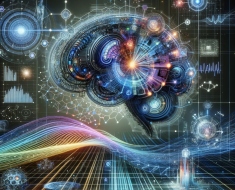Artificial Intelligence (AI) has permeated every aspect of our lives, revolutionizing industries and transforming the way we interact with technology. But what if AI had the potential to not only perform specific tasks, but to learn and think like a human? Enter Artificial General Intelligence (AGI), a concept that envisions a form of AI capable of surpassing human intelligence.
AGI represents the next step in AI evolution, as it possesses the ability to perform any intellectual task that humans can, and potentially even excel beyond human capabilities. It stands apart from current AI, known as Artificial Narrow Intelligence (ANI), which is limited to specialized domains. AGI, on the other hand, transcends domains and encompass a wide range of abilities including abstract thinking, generalization, common sense reasoning, creativity, emotional understanding, and effective communication.
While achieving AGI is the ultimate goal of AI research, it remains a challenging endeavor. Current AI systems heavily rely on machine learning, which allows machines to learn from data and experiences. However, these systems are limited by the quality and quantity of training data, predefined algorithms, and optimization objectives. In contrast, AGI would be free from these limitations, relying instead on its own learning and thinking capabilities, and integrating knowledge from diverse sources seamlessly.
The path towards AGI entails various challenges. One of the fundamental hurdles is defining and measuring intelligence, including complex components like memory, attention, creativity, and emotion. Additionally, modeling the human brain’s functions, such as perception and cognition, presents significant challenges. Designing scalable learning and reasoning algorithms, ensuring the safety and reliability of AGI systems, and aligning their values and goals with society are all vital considerations.
Researchers have explored different approaches in the pursuit of AGI. Symbolic AI utilizes logic and symbols for knowledge representation and manipulation, while Connectionist AI employs neural networks and deep learning to process large amounts of data. Hybrid AI combines the strengths of both approaches, while Evolutionary AI uses evolutionary algorithms to evolve solutions through natural selection. Neuromorphic AI aims to emulate biological neural systems, enabling more efficient and realistic brain models.
While true AGI has not yet been achieved, there are notable AI systems that exhibit certain aspects of AGI, such as AlphaZero, which autonomously learns to play chess, shogi, and Go. OpenAI’s GPT-3 is capable of generating coherent texts across various domains, while NEAT evolves neural networks for complex tasks. These examples demonstrate progress, but also reveal existing limitations that require further exploration.
The implications of AGI are vast and extend beyond scientific and technological domains. Economically, AGI may create new opportunities and disrupt existing markets. Socially and ethically, AGI raises questions about its impact on employment, privacy, autonomy, and the potential risks associated with creating and controlling highly intelligent systems.
As we journey towards AGI, a careful and balanced approach is crucial. It is essential to address the technical challenges, while considering the societal and ethical implications. AGI has the potential to unlock new frontiers of human progress, but it also demands responsible development and deployment to ensure a future that benefits all of humanity.
FAQ on Artificial General Intelligence (AGI)
1. What is Artificial General Intelligence (AGI)?
AGI refers to a form of AI that possesses the ability to perform any intellectual task that humans can and potentially even excel beyond human capabilities.
2. How is AGI different from current AI?
AGI stands apart from current AI, known as Artificial Narrow Intelligence (ANI), which is limited to specialized domains. AGI transcends domains and encompasses a wide range of abilities, including abstract thinking, generalization, common sense reasoning, creativity, emotional understanding, and effective communication.
3. What are some challenges in achieving AGI?
Defining and measuring intelligence, modeling human brain functions, designing scalable learning and reasoning algorithms, ensuring safety and reliability of AGI systems, and aligning their values and goals with society are all vital challenges in achieving AGI.
4. What are some approaches to AGI research?
Researchers have explored different approaches including Symbolic AI, Connectionist AI, Hybrid AI, Evolutionary AI, and Neuromorphic AI.
5. Are there any notable examples of AI systems exhibiting aspects of AGI?
While true AGI has not yet been achieved, there are notable AI systems like AlphaZero, OpenAI’s GPT-3, and NEAT that exhibit certain aspects of AGI. These systems possess capabilities such as autonomous learning and generating coherent texts.
6. What are the implications of AGI?
The implications of AGI are vast and extend beyond scientific and technological domains. Economically, AGI may create new opportunities and disrupt existing markets. Socially and ethically, AGI raises questions about its impact on employment, privacy, autonomy, and the potential risks associated with highly intelligent systems.
7. What approach is needed for AGI development?
A careful and balanced approach is crucial for AGI development. It is important to address the technical challenges while considering the societal and ethical implications. Responsible development and deployment of AGI are necessary to ensure a future that benefits all of humanity.
For more information on Artificial Intelligence, you may visit: Association for the Advancement of Artificial Intelligence (AAAI)





![[repo] Awesome Machine Learning and Elixir – Other Resources [repo] Awesome Machine Learning and Elixir – Other Resources](https://aigumbo.com/wp-content/uploads/2024/01/301658d2571b34804e642eb7a28976609422ac3b-235x190.png)